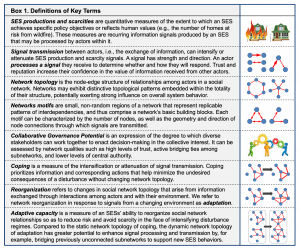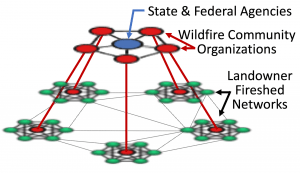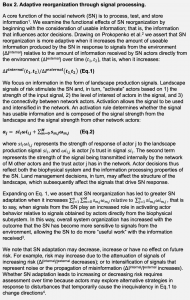Conceptual Framework
Fire-prone socio-environmental systems (SESs) are a global phenomenon where human communities exist in proximity to flammable ecosystems. In the US and elsewhere, the wildland-urban interface (WUI) exemplifies an SES with increasing risk due to fire suppression, population growth, and climate change. Attempts to reduce fuels by restoring fire-adapted ecosystems and historic fire regimes are socially unacceptable in many regions, creating a fire suppression paradox where suppression increases future risk, reduces funds for risk mitigation, and encourages new home development by offering a false sense of security.
We seek to explain where, when, why and how increasing wildfire risk causes human institutions to change in ways that increase or decrease adaptive capacity, and how changes in adaptive capacity alter the environments and ecosystems that produce wildfire and associated risks such as smoke. We propose a network perspective of socio-environmental dynamics (Figure 1A) and apply it in fire-prone WUIs of the US Intermountain West (IMW) (Figure 1B). By strategically integrating empirical data with our modeling platform, we explore and test how social networks interact with disturbance regimes to alter risk, and to enhance or constrain adaptive capacity. In doing so we contribute to a theory of adaptive capacity in integrated socio-environmental systems (SESs). 
Figure 1. Fire-Prone Integrated SESs Components and Dynamics. (A) Generalized systems model. Biophysical and sociocultural subsystems are integrated when signals span subsystems. Actors select management actions based on their objectives and values in response to risk signals they perceive from the biophysical subsystem and the trust they place in signals received from the sociocultural subsystem’s social networks. Management actions alter ecosystems and disturbance regimes while influencing the social network’s topology and signal transmission. External drivers such as climate or human population change may directly influence either subsystem and thus alter the signals sent to actors. (B) Specific integrated system components and interactions of this project.
Theory & Terminology
At the core of our proposal is a conceptual model of SES signals, interactions and information-based feedbacks (Figure 1A) with its emphasis on structural and functional components of each subsystem as mediated by actors with their associated objectives and values. Actors receive signals from biophysical disturbances as information about hazard and risk, as well as signals from the social network associated with recommended actions, characterized by levels of trust and reputation for the signal’s source. Actors decisions return to the biophysical subsystem as management actions that can change ecosystems and disturbance regimes, and to the sociocultural system in the form of altered communications and relationships with other network actors that result in social network coping or adaptation.
Landscape trajectories in fire-prone SESs are thus a function of interactions and feedbacks between (1) sociocultural actors (e.g., landowners, organizations, and policy makers) who form an information-driven network of interactions with the SES and each other, and (2) disturbance regimes that produce and transmit information from the landscape to the social network. Actors in the social network tend to intensify or attenuate the information signals depending on existing interpersonal and organizational objectives and values. Signal processing, in turn, affects the SES’s ability to cope with or adapt to changing risks and uncertainties from biophysical disturbances, which, in turn, may affect the future disturbance regime. The ability to adapt to intensifying disturbance regimes is a critical function of SESs as they confront unprecedented disturbances due to climate change. We base our investigation on two axioms:
- Social networks manage risk from disturbances by processing and organizing information to regulate feedbacks between integrated sociocultural and environmental subsystems;
- When the magnitude and/or frequency of disturbances exceed the coping capacity of the existing social network structure, the network must adaptively reorganize to sustain valued landscape productions.
We hypothesize that some social network topological and functional features will better support the reorganization necessary for successful adaptation to disturbances outside the bounds of past experience. We differentiate adaptation from coping as changes in network topology, while noting that adaptation is a two-edged sword, with the potential to turn “the threat of adverse consequences into beneficial opportunities, or…turn a minor crisis into a catastrophe” (Adger et al., p.96). Based on these precepts, we next highlight how our socio-environmental interactions framework can help explain the adaptation challenges faced by WUI communities. To link theory to tools, we define key terms in ways that can represent the lived experience of people in fire-prone areas, while supporting measurement and hypothesis testing in empirical and modeling studies (Box 1). 
The need for adaptation and adaptive capacity have become increasingly apparent as evidence of climate change impacts grows, while efforts to curtail emissions fall short of levels needed to forestall increasingly severe impacts. The inexorable increase of climate change impacts suggests the need for greater focus on those adaptation pathways where the potential for human control is greatest. Despite this need, there is no widely accepted theoretical framework for understanding how SESs reorganize to enhance sociocultural adaptive capacity in response to intensifying disturbance regimes, or how, in turn, sociocultural adaptations may influence future disturbances.
For a social network to successfully adapt to changing risk, risk signals must be processed and organized so that they improve the quality of information and the reliability of its predictions. Appropriate risk perception increases information that social network actors can use to mitigate risk. To the extent that mitigation actions successfully reduce risk, the information these actions send becomes more trusted. As the social network processes this information, reorganization can occur as actors dynamically restructure their relationships to be more heavily influenced by those who provide more trustworthy information. Reorganization may include hierarchically organized relationships generated through new or existing institutions such as wildfire community organizations who mediate between agencies like the state Dept. of Forestry and on-the-ground landowner networks, forming a new network motif (Figure 2).

Figure 2. Wildfire social network reorganization occurred as NGOs began to act as intermediaries between state/federal agencies and private landowners.
We therefore establish a measure of adaptive capacity as the degree to which changes in the structure of social network relationships (i.e., its topology) increase the SES’s capacity to sustain valued productions in the face of signals from a changing environment. By defining a) coping capacity as the degree to which the existing social network topology can sustain SES productions via changes to signal processing alone, and b) adaptation as the degree to which changes to social network topology are required to sustain productions, we derive adaptive capacity as the difference between the system’s ability to sustain valued landscape productions under a static versus dynamic social network.
We are using this metric to explore and test the mechanisms through which guided reorganization of actual social networks may increase adaptive capacity in real-world SESs. Through this, we aim to shed light on features of social networks that may be the best candidates for reducing climate-driven impacts from intensifying wildfire regimes, and to identify, test and validate transferable interventions that can enhance a SES’s ability to successfully cope with and adapt to changing risk.

Building Bridges Between Theory and Lived Experience
To build bridges between theory and people’s lived experience, we are working with our Stakeholder Advisory Committee to explore the qualities that make a wildfire management network successful in the face of increasing risk from wildfire. For example:
- What is the importance of network structure, i.e. the topology of nodes and edges, versus function, i.e. the qualities of edges between nodes, or in everyday language, the qualities of relationships between people or organizations, such as their degree of trust in one another?
- What is the role of leadership? Is it a quality of individuals who occupy certain positions within the network, or an emergent quality of of the network itself?
Because network topology can be extremely complex (Figure 3), we seek to identify repeatable network subpatterns, or motifs, that may serve as building blocks of network function (Figure 4). To this end, we have created a Network Grammar of motifs and how they may work individually or together to guide signal processing as a means to develop abstract network concepts that are guided by the lived experiences of wildfire managers.

Figure 3. Central Washington wildfire management network.

Figure 4. Network motifs representing wildfire risk managers and their relationships. (A) A centralized motif, e.g. an incident command team. (B) Bonding motif, e.g. between environmental organizations whose shared values (represented in green) allow relationships to be activated when useful. Double-headed arrows represent reciprocity that strengthens trust between actors. (C) Bridging motif, e.g. between collaborative group members allowing dissimilar actors from connected networks to learn from one another and build trust.
Citations
- Holling, C.S., Understanding the Complexity of Economic, Ecological, and Social Systems. Ecosystems, 2001. 4(5): p. 390-405.
- Prokopenko, M. and C. Gershenson, Entropy Methods in Guided Self-Organisation. Entropy, 2014. 16(10): p. 5232.
- Kauffman, S.A., Investigations. 2000, Oxford: Oxford University Press.
- Prokopenko, M., F. Boschetti, and A.J. Ryan, An information-theoretic primer on complexity, self-organization, and emergence. Complexity, 2009. 15(1): p. 11-28.